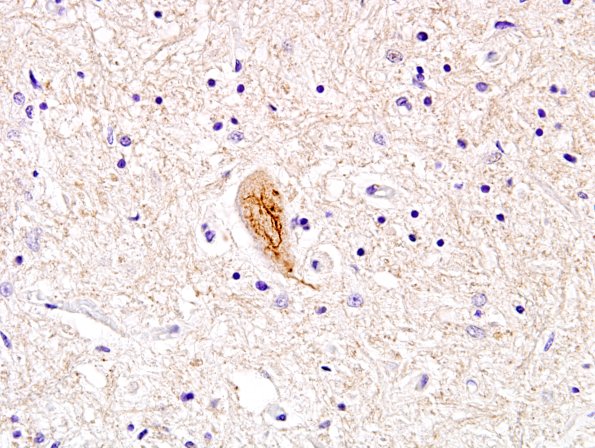Table of Contents
Washington University Experience | NEURODEGENERATION | ALS | 5G2 FTLD-ALS-TDP43 (Case 5) N13 TDP43 3.jpg
No Bunina bodies are observed on H&E stained sections. However, occasional TDP43-positive neuronal inclusions (skein-like and globose) are seen in the motor neurons of the anterior horns. (TDP43 IHC) ---- Not shown: There is moderate neuronal loss, extracellular and phagocytosed pigment and gliosis in the substantia nigra. There is pallor and loss of axons in the cerebral peduncles accompanied by scattered foamy cells and reactive astrocytes. No beta-amyloid deposits, no tangles and no Lewy bodies are seen but sparse TDP43 immunoreactive inclusions are present in the substantia nigra and red nucleus. There is loss of neurons from the hypoglossal nucleus.. No inclusions containing alpha-synuclein, beta-amyloid or tau are identified. ---- Diagnosis: Amyotrophic lateral sclerosis (motor neuron disease) and frontotemporal lobar degeneration with TDP43 proteinopathy ---- Neuro Diagnosis Comment: This case exhibits the stigmata of amyotrophic lateral sclerosis (ALS)/motor neuron disease (MND): upper and lower motor neuron loss, corticospinal tract degeneration, and infrequent TDP43- immunoreactive neuronal cytoplasmic inclusions. In addition, there were cognitive deficits, and the loss of neurons in the cortex of the prefrontal and temporal lobes together with modest TDP43 proteinopathy indicates the presence of frontotemporal lobar degeneration (FTLD). Motor neuron disease and FTLD are seen as part of a disease spectrum linked by a common molecular pathology, TDP43 proteinopathy (FTLD-MND-TDP). The most frequent genetic cause of FTLD-MND-TDP is an expansion of a hexanucleotide repeat in the C9orf72 gene as was the case in this family member. Representative neocortical sections show patches of diffuse beta-amyloid plaques. Using the National Institute on Aging-Alzheimer's Association (NIA-AA) criteria, this case has neuropathological change A1B1C0 which indicates that the AD pathology has a ‘low’ probability of causing the cognitive changes. The absence of Lewy bodies excludes Parkinson’s disease and dementia with Lewy bodies as diagnostic considerations. In conclusion, the patient's motor and cognitive problems can be explained by one neurodegenerative disease: ALS/MND/FTLD-TDP with a hexanucleotide expansion in the C9orf72 gene.

